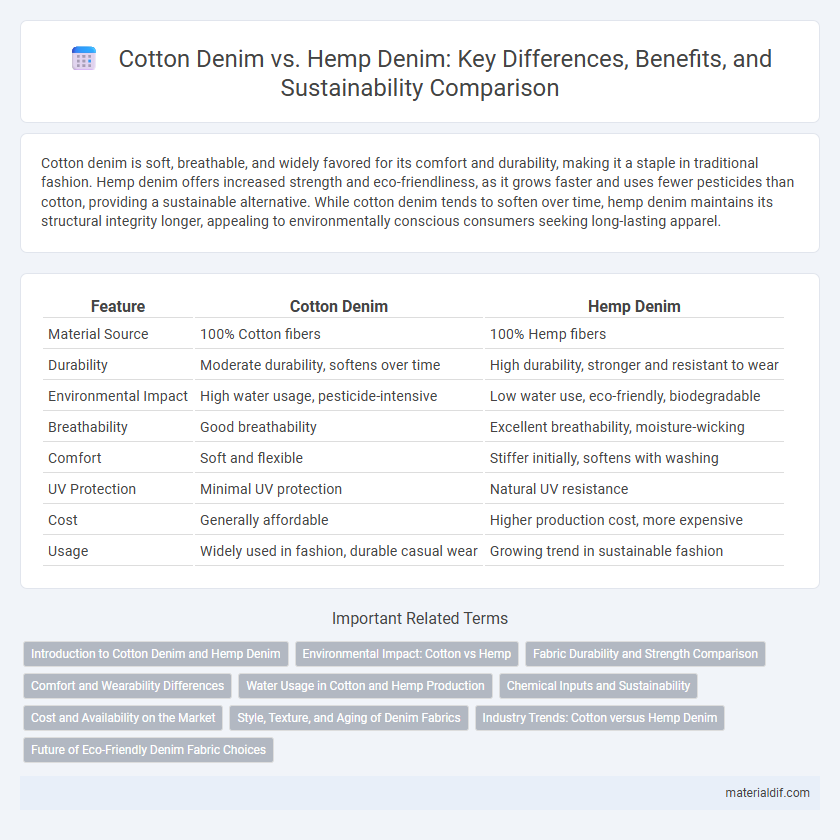Cotton denim is soft, breathable, and widely favored for its comfort and durability, making it a staple in traditional fashion. Hemp denim offers increased strength and eco-friendliness, as it grows faster and uses fewer pesticides than cotton, providing a sustainable alternative. While cotton denim tends to soften over time, hemp denim maintains its structural integrity longer, appealing to environmentally conscious consumers seeking long-lasting apparel.
Table of Comparison
| Feature | Cotton Denim | Hemp Denim |
|---|---|---|
| Material Source | 100% Cotton fibers | 100% Hemp fibers |
| Durability | Moderate durability, softens over time | High durability, stronger and resistant to wear |
| Environmental Impact | High water usage, pesticide-intensive | Low water use, eco-friendly, biodegradable |
| Breathability | Good breathability | Excellent breathability, moisture-wicking |
| Comfort | Soft and flexible | Stiffer initially, softens with washing |
| UV Protection | Minimal UV protection | Natural UV resistance |
| Cost | Generally affordable | Higher production cost, more expensive |
| Usage | Widely used in fashion, durable casual wear | Growing trend in sustainable fashion |
Introduction to Cotton Denim and Hemp Denim
Cotton denim, traditionally crafted from 100% cotton fibers, offers exceptional softness, durability, and breathability, making it a staple in the fashion industry. Hemp denim, derived from hemp fibers, provides a sustainable alternative known for its natural strength, resistance to wear, and eco-friendly cultivation process. Both materials bring unique qualities to denim production, with cotton emphasizing comfort and hemp prioritizing environmental benefits and longevity.
Environmental Impact: Cotton vs Hemp
Hemp denim significantly outperforms cotton denim in environmental sustainability due to hemp's lower water consumption and reduced pesticide requirements. Cotton cultivation accounts for nearly 20% of global pesticide use and depletes large volumes of freshwater, whereas hemp grows quickly with minimal chemical inputs and enhances soil health. This makes hemp denim a more eco-friendly alternative, reducing the textile industry's carbon footprint and preserving natural resources.
Fabric Durability and Strength Comparison
Cotton denim is known for its softness and flexibility but tends to wear out faster under heavy use compared to hemp denim, which offers superior durability and tensile strength due to its longer fibers. Hemp fibers resist abrasion and tearing better, making hemp denim highly suitable for workwear and long-lasting garments. Blending hemp with cotton can enhance fabric strength while maintaining comfort, creating an optimal balance for durable denim products.
Comfort and Wearability Differences
Cotton denim offers a soft, breathable texture that becomes more comfortable with wear, making it ideal for everyday apparel. Hemp denim provides superior durability and moisture-wicking properties, enhancing comfort in warmer climates and extending garment lifespan. The natural fibers in hemp contribute to a slightly stiffer feel initially but soften over time, balancing wearability with environmental benefits.
Water Usage in Cotton and Hemp Production
Cotton denim production requires approximately 10,000 liters of water per kilogram of fiber, making it one of the most water-intensive crops globally. Hemp denim, by contrast, uses significantly less water, often only about 300 to 500 liters per kilogram, due to its resilient nature and lower irrigation needs. Choosing hemp denim reduces water consumption by over 90%, contributing to more sustainable textile manufacturing.
Chemical Inputs and Sustainability
Cotton denim production typically involves high volumes of synthetic pesticides and fertilizers, contributing to soil degradation and water pollution, while hemp denim requires fewer chemical inputs due to its natural pest resistance and low nutrient demands. Hemp cultivation also absorbs more CO2 per hectare compared to cotton, enhancing its sustainability profile. The reduced reliance on chemicals and faster growth cycle of hemp make hemp denim a more eco-friendly alternative in sustainable fashion.
Cost and Availability on the Market
Cotton denim dominates the market due to its widespread availability and lower production costs, benefiting from decades of established cotton farming infrastructure. Hemp denim, while more sustainable and durable, remains costlier because of limited hemp cultivation and less developed processing technology. Market availability favors cotton denim, with hemp denim slowly gaining traction in niche eco-friendly fashion segments.
Style, Texture, and Aging of Denim Fabrics
Cotton denim offers a soft, pliable texture with classic fading and whiskering patterns that develop character over time, favored for its traditional vintage style. Hemp denim boasts a coarser, more rigid texture that softens with wear and showcases unique aging through natural fiber breakdown, resulting in a distinct, sustainable aesthetic. Both fabrics provide durable options but cater to different style preferences and aging behaviors, with cotton emphasizing softness and hemp highlighting eco-friendly ruggedness.
Industry Trends: Cotton versus Hemp Denim
Cotton denim remains the dominant material in the global denim industry due to its softness, durability, and extensive cultivation infrastructure, accounting for over 90% of denim production. Hemp denim is gaining traction as an eco-friendly alternative, offering superior strength, breathability, and requiring fewer pesticides and water, aligning with rising consumer demand for sustainable fashion. Market trends indicate a gradual shift toward hemp blends, projected to grow annually by 8-10% as brands and manufacturers prioritize environmental impact and resource efficiency.
Future of Eco-Friendly Denim Fabric Choices
Cotton denim remains the dominant fabric in the denim industry largely due to its softness and durability, but hemp denim is rapidly gaining traction as a sustainable alternative with superior environmental benefits such as lower water usage and faster growth cycles. Brands increasingly incorporate hemp blends to reduce carbon footprints and promote biodegradability in their collections. Innovations in hemp fiber processing and fabric finishing are expected to drive the future market for eco-friendly denim fabrics, aligning with consumer demand for sustainable fashion.
Cotton Denim vs Hemp Denim Infographic

 materialdif.com
materialdif.com